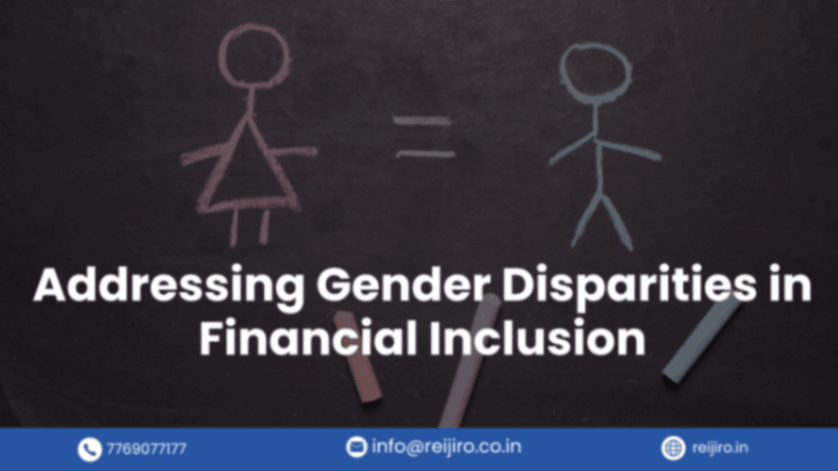Addressing Gender Disparities in Financial Inclusion
Financial inclusion, the accessibility and usage of a range of financial services by all members of society, is a critical driver of economic growth, poverty reduction, and empowerment. However, despite progress, gender disparities persist in financial inclusion efforts worldwide. Women, particularly in developing countries, often face significant barriers that limit their access to formal financial services and the benefits they bring. In this comprehensive blog, we delve into the root causes of gender disparities in financial inclusion, explore the impact of these disparities, and examine strategies and initiatives aimed at addressing them.
Understanding Gender Disparities in Financial Inclusion
Financial inclusion, the process of ensuring that all individuals and communities have access to affordable and appropriate financial services, is a fundamental goal for promoting economic growth, reducing poverty, and fostering social development. However, despite significant progress in expanding financial services globally, gender disparities persist, with women often being disproportionately excluded from the benefits of formal financial systems. Understanding the root causes of gender disparities in financial inclusion is crucial for designing effective policies and initiatives that address these inequalities.Gender disparities in financial inclusion stem from a complex interplay of social, cultural, economic, and institutional factors. These disparities manifest in various ways:
Limited Access to Banking Services: Women are more likely to lack access to formal banking services, including savings accounts, credit, insurance, and digital payment platforms. Cultural norms and the perception of women’s financial roles contribute to this exclusion.
Low Financial Literacy: Women often have lower levels of financial literacy, making it challenging for them to understand and navigate complex financial products and services.
Legal and Regulatory Barriers: In many countries, legal and regulatory frameworks can restrict women’s access to financial services. For example, laws preventing women from owning property can limit their ability to use assets as collateral for loans.
Cultural Norms and Gender Roles: Societal norms often dictate traditional gender roles, constraining women’s mobility and decision-making power. These norms can influence women’s participation in financial activities.
Lack of Identification Documents: Women’s lack of official identification documents, due to cultural norms or bureaucratic hurdles, can prevent them from opening accounts or accessing services.
Root Causes of Gender Disparities
The gender disparities in financial inclusion are rooted in complex interplays of social, economic, and cultural factors:
Gender Roles and Norms: Societal expectations often assign distinct roles to men and women. Women may be primarily responsible for caregiving and household duties, leaving them with less time and autonomy to engage with financial matters.
Lack of Control Over Resources: Limited control over income and assets can undermine women’s financial autonomy. Women’s inability to use assets as collateral for loans affects their access to credit.
Unequal Access to Education: Inadequate educational opportunities for girls and women can perpetuate lower financial literacy rates and hinder their understanding of financial concepts.
Workforce Disparities: Gender wage gaps and uneven participation in the formal workforce can limit women’s ability to generate income and accumulate savings.
Violence and Discrimination: Gender-based violence and discrimination can further marginalize women and limit their ability to access financial services independently.
Institutional Biases: Financial institutions may hold biased perceptions about women’s creditworthiness, influencing loan approval processes and terms.
Impact of Gender Disparities in Financial Inclusion
The consequences of gender disparities in financial inclusion are far-reaching and affect both individuals and economies:
Economic Empowerment: Financial inclusion can empower women by providing them with tools to manage finances, invest in education, start businesses, and contribute to household income.
Poverty Reduction: Women’s economic empowerment through financial inclusion has a direct impact on poverty reduction, as it enhances their ability to save, invest, and generate income.
Entrepreneurship and Innovation: When women have access to credit and financial resources, they are more likely to engage in entrepreneurial activities, fostering economic growth and innovation.
Health and Education: Financial inclusion enables women to access health services and education, improving their well-being and the quality of life for their families.
Gender Equality: Addressing gender disparities in financial inclusion is a step toward achieving broader gender equality goals, as it challenges traditional gender roles and empowers women to participate in economic decision-making.
Strategies to Address Gender Disparities
Strategies to Address Gender Disparities in Financial Inclusion
Gender disparities in financial inclusion are a significant barrier to economic growth and social development. To address these disparities and create a more inclusive financial ecosystem, governments, financial institutions, non-governmental organizations (NGOs), and international organizations are implementing various strategies. These strategies aim to empower women economically, enhance their financial capabilities, and ensure their equal participation in formal financial systems. Here are some effective strategies being employed:
1. Financial Literacy and Education Programs:
Educating women about financial concepts, products, and services is crucial for enhancing their financial decision-making abilities. Financial literacy programs can empower women to understand and navigate the financial landscape, promoting more informed choices.
2. Tailored Financial Products:
Designing financial products specifically for women’s needs can address their unique circumstances. Microloans for women-led businesses, savings accounts with lower minimum balances, and insurance products that cater to women’s priorities are examples of tailored solutions.
3. Digital Financial Services:
Digital platforms and mobile banking can overcome traditional barriers to financial access. Mobile money and digital wallets provide women with convenient, secure, and private ways to save, transfer money, and make payments.
4. Legal Reforms:
Addressing legal barriers, such as discriminatory property ownership laws, can enhance women’s access to credit and financial services. Reforming these laws can help women leverage assets for loans and financial transactions.
5. Gender-Responsive Regulations:
Regulatory frameworks that consider gender-specific barriers can encourage financial institutions to develop products and services that cater to women’s needs. These regulations can also ensure fair treatment and equal opportunities for women.
6. Women’s Economic Empowerment Programs:
Combining financial inclusion initiatives with training in business skills, entrepreneurship, and vocational training can empower women to engage in income-generating activities and enhance their economic independence.
7. Promoting Women’s Leadership:
Encouraging women’s representation in leadership positions within financial institutions can foster an environment that understands and caters to women’s financial needs.
8. Data Collection and Analysis:
Collecting gender-disaggregated data can help identify trends, challenges, and opportunities related to women’s financial inclusion. Data-driven insights can inform the design of effective policies and interventions.
9. Partnerships and Collaboration:
Collaboration among governments, financial institutions, NGOs, and international organizations can pool resources, expertise, and networks to design and implement comprehensive gender-inclusive financial inclusion strategies.
Successful Initiatives
Across the globe, various successful initiatives have been implemented to address gender disparities in financial inclusion. These initiatives have demonstrated the effectiveness of targeted strategies and innovative approaches in empowering women economically, increasing their access to financial services, and promoting gender equality. Here are some noteworthy examples of successful initiatives:
1. Self-Help Groups in India:
India’s Self-Help Groups (SHGs) are community-based microfinance organizations that have transformed the lives of millions of women. SHGs provide a platform for women to pool their savings, access credit, and receive training in financial management and entrepreneurship. These groups empower women economically and socially while enhancing their financial inclusion.
2. Banco Adopem in the Dominican Republic:
Banco Adopem, a microfinance institution in the Dominican Republic, offers microloans specifically tailored to women. The institution recognizes the role of women in driving economic development and provides financial products that cater to their needs. This approach has contributed to the growth of women-led businesses and improved financial inclusion.
3. Tanzania’s Women’s World Banking Program:
Tanzania’s partnership with Women’s World Banking has resulted in the development of financial products designed to address the unique financial needs of women. These products include savings accounts, loans, and insurance. The initiative has successfully increased women’s access to financial services and improved their economic resilience.
4. Kenya’s M-Pesa:
While not exclusively targeted at women, Kenya’s mobile money platform M-Pesa has had a significant impact on women’s financial inclusion. The platform enables women, especially those in rural areas, to save, transfer money, and access financial services through their mobile phones. M-Pesa has contributed to women’s economic empowerment by providing them with a safe and convenient way to manage their finances.
5. PASCH in Peru:
The Programa de Ahorro y Crédito Hipotecario (PASCH) in Peru focuses on providing housing loans to low-income women. By offering financial services that enable women to invest in property ownership, PASCH contributes to their economic stability and empowers them as homeowners.
6. Grameen Bank in Bangladesh:
The Grameen Bank, founded by Muhammad Yunus, pioneered microfinance and prioritized lending to women. By providing small loans to women for income-generating activities, the Grameen Bank has empowered countless women to start businesses, improve their families’ living conditions, and gain financial independence.
7. SHE Investments in Cambodia:
SHE Investments in Cambodia focuses on empowering women entrepreneurs. The initiative offers training, mentoring, and access to finance for women-led businesses. By addressing the unique challenges women face in business, SHE Investments supports women in building successful enterprises.
8. Rwandan Women’s Savings Groups:
In Rwanda, women’s savings groups have been established to promote financial inclusion and economic empowerment. These groups encourage women to save, access credit, and receive financial education. The initiative has led to increased financial resilience and improved livelihoods among participants.
9. Philippines’ Grameen Replication Program:
The Grameen Replication Program in the Philippines adapts the Grameen Bank’s microfinance model to local contexts. By focusing on women’s participation, the program has enabled women to access credit, start businesses, and contribute to their families’ economic well-being.
Conclusion
Addressing gender disparities in financial inclusion is not just a matter of social justice; it is a critical step towards creating inclusive and thriving economies. This comprehensive exploration has shed light on the various facets of gender disparities in financial inclusion, their underlying causes, and the strategies and successful initiatives aimed at rectifying these inequalities.
The understanding of gender disparities goes beyond acknowledging the differences; it involves recognizing the systemic barriers that women face in accessing and benefiting from financial services. These barriers, rooted in cultural norms, economic structures, and legal frameworks, have far-reaching implications for women’s economic empowerment, poverty reduction, and overall well-being.



